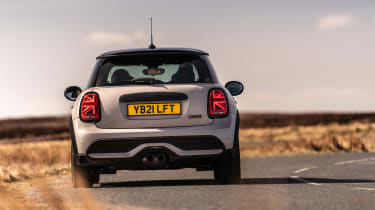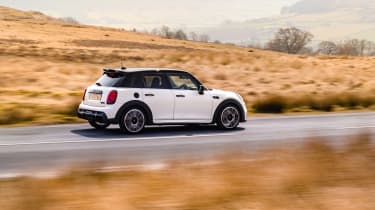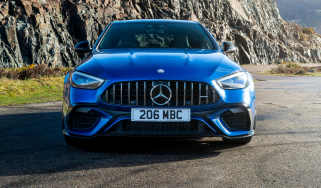Mini Cooper review – ride and handling
A quick steering rack, tight suspension calibration and enthusiastic response from the driver controls make it feel peppy, but not exactly engaging
When the first BMW-engineered R53 Mini hatch was launched in 2001 its nostalgic styling and clever detailing might have made it a hit on the sales charts, but its superb handling characteristics also proved BMW hadn’t cut corners on its first-ever front-wheel hatchback.
The bespoke platform was a great one, with a low centre of gravity and square stance on the road complemented by the unusual application (for a supermini) of multi-link rear suspension. As a result, the Mini had real talent on the road, with a snappy front end and sure-footed handling that always seemed to grip no matter the circumstance. The next-generation Mini, revealed in 2007, was built on this same platform, improving ride quality and refinement along the way. Both, in short, felt like proper ‘Minis’, even if they were significantly larger than the classics from which their name was derived.
Unfortunately, with BMW wanting to spread the development costs of the Mini’s front-wheel-drive platform, the third-generation F55 moved over to a larger modular chassis shared with BMW’s 1-series, 2-series Active Tourer and X1 crossover, changing not only the way the new model looked, but also softening its driving experience along with it. It’s still well sorted in that precise BMW way, but the pointed aggression and stance that defined previous generations had gone, leaving a far less interesting proposition in its wake.
More reviews
In-depth reviews
Reviews
> Mini John Cooper Works 1to6 Edition launched to celebrate the manual gearbox
Over time, it’s a feeling that’s only been compounded, something made worse by its very odd ergonomics. The seating position does allow you to get relatively low in the chassis – a nice change from most supermini rivals – but the towering dash makes it feel like you’re standing at a rock face, or make that a climbing wall at a county fete with all those distracting LED lighting elements. More of a fundamental issue is the relationship between the steering wheel and gearstick, making the whole process of driving quickly a fumbling mess.
The flip side of this frustrating pivot has been a big jump in refinement, something that in reality appeals to most buyers.The steering, although sharp, doesn’t communicate much information about the road surface, nor how much the front tyres have to give. The ride quality is well judged, and even over rough surfaces maintains composure whilst never deteriorating to the point of discomfort. There is no doubt that the Mini still just about holds on to its dynamic edge over its more pedestrian rivals, but the distinction between settled premium hatch and basic hatch seems to be thinner than ever.
Push further up the range and the John Cooper Works models increase roll stiffness, but the sophisticated damping rarely feels out of step, even if overall ride quality becomes a little more compromised. Body control, as a result, is improved, while any sign of traction deterioration is made up for by the stickier tyre compound.
The Mini Electric on the other hand is probably the best of the bunch around corners, as while there’s more weight to deal with (around 240kg more compared to the Cooper S) it’s fixed down low in the chassis, helping mimic that typical ‘Mini’ feeling that’s more about precision than over-the-limit fun. Unfortunately, the trade-off is the seating position, which is slightly higher than in the standard car, and therefore erodes some of this new-found zest.





